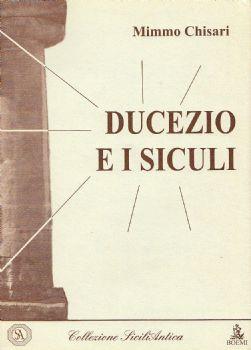Mimmo Chisari
Ed. Boemi, Catania 2009
pp. 85
First work of a series (Collezione SiciliAntica) that the publisher wanted to dedicate to all lovers of Sicilian archeology and history, Ducezio and the Siculi is the result of a detailed research work conducted by the author, Mimmo Chisari, starting from the first settlements of the Siculi on the island, up to the mythical figure of Ducezio.
"Sicily was at the center of the ancient mare nostrum, a crossroads of peoples and civilizations, a meeting and amalgamation of spaces, men, stories and traditions." And thus, analyzing the only sources available, the Historical Library of Diodoro Siculo and Sicilian Archeology of Thucydides, we come across populations such as the Sicans, the Elymians and the Sicilians, the latter probably coming to Sicily around 1050 BC, three centuries before the arrival of the Greeks. But "reconstructing their history becomes a very complex undertaking because the Sicilians have not left written records.
"However, sites such as Pantalica, located in the Anapo valley and protected by UNESCO, Morgantina, bear witness to their work, whose foundation dates back to the 11th century BC and Mendolito, one of the most important centers of the Sicilians, located in the territory of Adrano where, according to what described by Claudio Eliano in the De Natura Animalium, a sanctuary would have been erected, protected by sacred dogs, in honor of the god of this city of the same name, but Adrano was not the only divinity of the Sicilians "Their religion was founded on the cult of Mother Earth and its deep recesses, on the gods of the underworld rather than on those of the sky. Their cults were aimed above all at dark and underground forces connected to the natural phenomena of Etna volcanism".
And so we find the cult of Demeter and Kore, Sicilian gods linked to agriculture. We also find the cult of the Palici, transformed by the Greeks into twins born from the union between Zeus and the nymph Talia and venerated at a lake, now no longer visible and named Naftia. And it is precisely at this lake that Ducezio founded Palikè, "a sacred city destined to become an important political and religious center."
Born between the 490 and the 480 aCa Mineo, where the remains still exist a fortress called Castello di Ducezio, he “was a leading figure of the Sicilian revolt against the invading Greeks, a great man of action, a hero and a sensitive diplomat, a skilled leader ".
Probably Ducezio was not his real name but a name due to his qualities. His mission was to achieve the union between the Sicilian city states in order to stop the advance of the Greeks within the island. He initially conquered Catania, in the 460 BC, then Morgantina, to be defeated, in the 450 BC by a coalition between Agrigento and Syracuse, in the battle of Nomai, a town located between Enna and Caltanissetta near the Montagna di Marzo. A bloody battle where many Siculi perished. Ducezio, pardoned by the Syracusan people, was sent into exile in Corinth from where, having heard a divine oracle, probably that of the city of Dodona, resumed, after a period of time, to sail the seas towards Sicily. Landed on the northern coast of the island, he founded the city of Kale Acte where, as Diodorus Siculus tells us, he died suddenly, struck by an illness, around 440 BC
To emphasize the end of the dream of creating a Sicilian nation, Valentino Cardani, in the novel dedicated to him, writes: "Ducezio is dead ... the light went out in the land of Siculi. And it was forever. "
Gianlorenzo Capano












